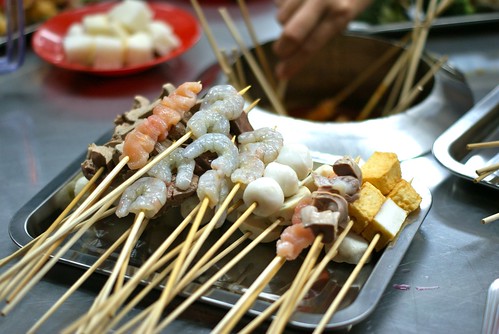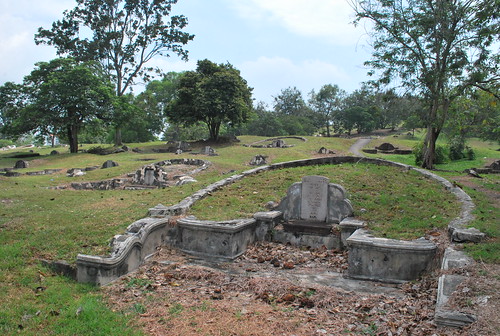
The Chinese had flocked to Melaka since the early days of mass migration from the southern provinces of China. The various clans of Hokkien, Cantonese, Hakka, Teochew and Hainanese Chinese still adhere to their individual customs, traditions, food, languages and cultural characteristics with each clan usually specialising in its particular trade.

Hainanese Chicken Rice Ball

Satay Celup
Bukit China is the largest Chinese cemetery outside of mainland China. Graves can be found here that go back to the late Ming dynasty (mid 17th century). The earliest grave found so far dates to 1622, but unfortunately many graves were exhumed during the British occupation of Malaysia.

Bukit China Cemetery
Somewhat earlier, the Portuguese built a Franciscan chapel on this hill dedicated to "Madre de Deus" (Mother of God) but it was destroyed along with an adjacent monastery during the Achinese attack of 1629.
The early cemetery that existed on this site (including the one grave dated to 1622) was fairly small. The site was greatly expanded during the Dutch occupation when Kapitan China (a Portuguese term for the head of the Chinese community) Lee Wei King bought the hill from the Dutch and donated it to the Chinese community of Melaka for use as a burial ground.
It now contains over 12,500 graves and is almost full. Public burials have ceased, and what few open plots remain are reserved for members of the Standing and Advisory committee of Cheng Hoon Teng temple.

One of the oldest functioning Chinese temple in Malaysia, Melaka Cheng Hoon Teng Temple was founded by Kapitan Lee Wei King in 1645s. The position of Kapitan was created by Portuguese as an administrator of local Chinese community. The meaning of “Cheng Hoon Teng” is Chinese word is Temple of Clear Cloud.
Cheng Hoon Teng Temple
During 17th century, Melaka Cheng Hoon Teng Temple was served as the official administrative centre and court of Justice of the Kapitans. The members of Kapitan were Tay Hong Yong (alias Tay Kie Ki), Chan Lak Kua and Chua Su Cheong.


In 1704s, Chan Ki Lock started the construction of the main hall and was rebuilt by Kapitan Chua Su Cheong in 1801s. Melaka Cheng Hoon Teng Temple was underscored by an UNESCO award for understanding architectual restoration and is the central to the spiritual asipiration of the Chinese community in historic Melaka among the most significant in Southeast Asia.
